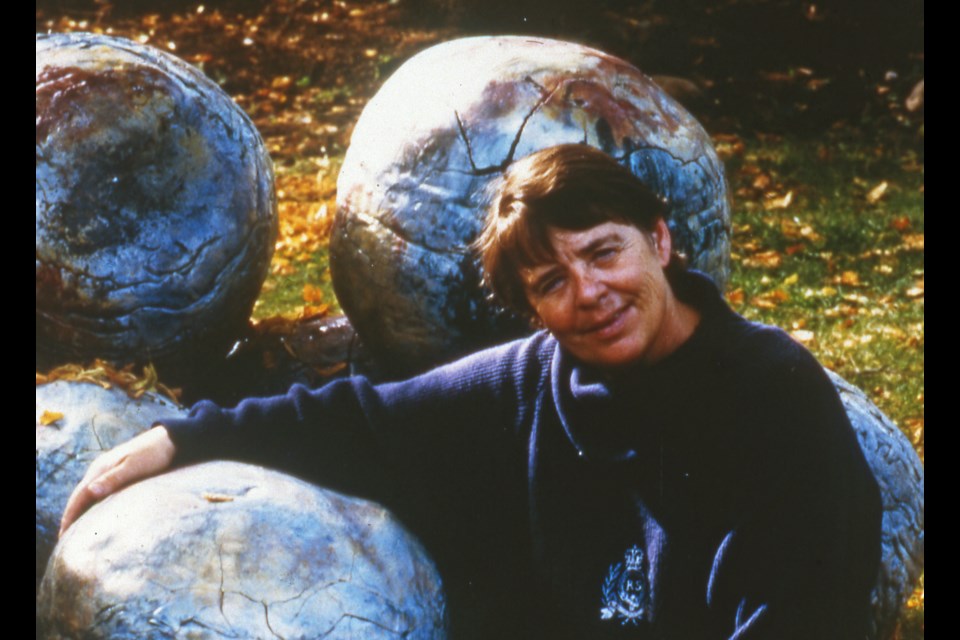The Art Gallery of St. Albert is set to pay tribute to one of the city’s most influential leaders, a woman of vision who was as passionate about creating stunning ceramics as she was protecting the natural environment.
The exhibition, called Fire In Her Hands, honours the artistic and environmental legacy of Elke Blodgett, who died in 2018.
Standing at a compact five-foot-one, Elke Blodgett was a force nature. Known simply as “Elke,” she was an engaged citizen and strong environmental advocate who spoke her mind and challenged city politicians to deliver solutions that would preserve our landscape.
Several of Elke’s most publicized battles were against pesticide overuse, our mountainous landfills, bird-killing power lines, and plans for building roads through watershed areas. While decades of former councillors found it easier to ignore her protests rather than find solutions, many respected her tireless determination and concern.
As a raku potter, her artistic creations were sensitive and deeply personal, often arising from “dreams.” From spring to autumn, Elke’s “dreams” took shape at her studio named WoodHouse. Built from reclaimed wood, it was on a plot of land near Pembina surrounded by big skies, stands of trees and nature’s creatures — a serene landscape where Elke’s visions came to fruition.
Rather than throwing the clay, Elke’s raku pottery was hand-shaped, and kiln-fired at high temperatures in an outdoor space. After the pieces were fired, they were cooled in a garbage can and filled with combustible material such as moss or wood chips that gives raku a variety of colours and surface effects.
“Her works feel otherworldly, not like anything anyone else has created. The works feel ancient, like they walked out of the mists of time,” said gallery curator Emily Baker.
Baker worked closely with Elke’s daughter, Astrid, and son, Gunnar, to compile Fire in Her Hands, the first retrospective of Elke’s visionary raku pottery. The commemoration opens to the public with an in-person tour on Thursday, July 11 at 6:30 p.m., and will showcase some of her innovative techniques.
Designed to highlight Elke’s status as a prominent ceramicist, the gallery showcase contains 20 sculptural pieces ranging from the 1960s to the 1990s when she retired. The exhibit also recreates portions of unfinished works, unveils a collection of photographs and airs a video about her life.
“I feel I learned so much about her work through her writings. This is the first exhibition I’ve curated where I couldn’t call an artist. Her writings shared her thoughts and they ranged from the toxicity in glazes and how they affected her, to some of her dreamy musings about her own art. Her artwork was a way to make visible a different part of herself she didn’t know,” said Baker.
Elke brought inspiring experimental artistry to her pottery, creating works of extraordinary beauty and energy.
“She had a need to create. She was always on the go. She had a driving intensity and ingenuity. She didn’t want to buy something if you could build it.”
Not only did Elke shape clay pots, she also built her own kiln and travelled across the province teaching other potters how to build and personalize their own kilns.
“At one point she had to change how she made pots. When she was building a roof, she fell off and broke her arm, and that challenged her how to make ceramics. She couldn’t make ceramics the way she’d been taught. She had a hard time coiling, building and throwing. She came up with a new technique sliding the piece of clay, flattening it and building little layers, little spirals.”
Interestingly, Elke never wanted to sell or give away her art said Baker.
“She only did it so she could buy more clay to make more pottery.”
Elke was a brilliant artist and a creative inventor. She also suffered from manganese toxicity, a disorder from a buildup of aerosolized manganese found in glazes for colouring pottery. The ceramic artist wrote about suffering from extreme fatigue, confusion, insomnia, nausea, white-out episodes, migraines and confusion.
"In her writings, she says she feels she lost years of her life."
Currently, Elke's raku pieces are found at the Banff Centre, Alberta Foundation for the Arts, Canada Council Art Bank, City of St. Albert, and the Consul General of Japan, as well as many private collections.
Two works from the Alberta Foundation for the Arts, Icarus and Palingenesis (rebirth/recreation) will also be part of the retrospective.
“They’re egg-shaped vessels, narrower at the bottom and wider at the top. She wanted to make works that felt precariously balanced.”
A reception with special guests will be held July 18 from 6 p.m. to 8 p.m. at the gallery on Perron Street, and a virtual tour goes at noon on July 31 on Facebook Live. The exhibition runs until Aug. 10.




